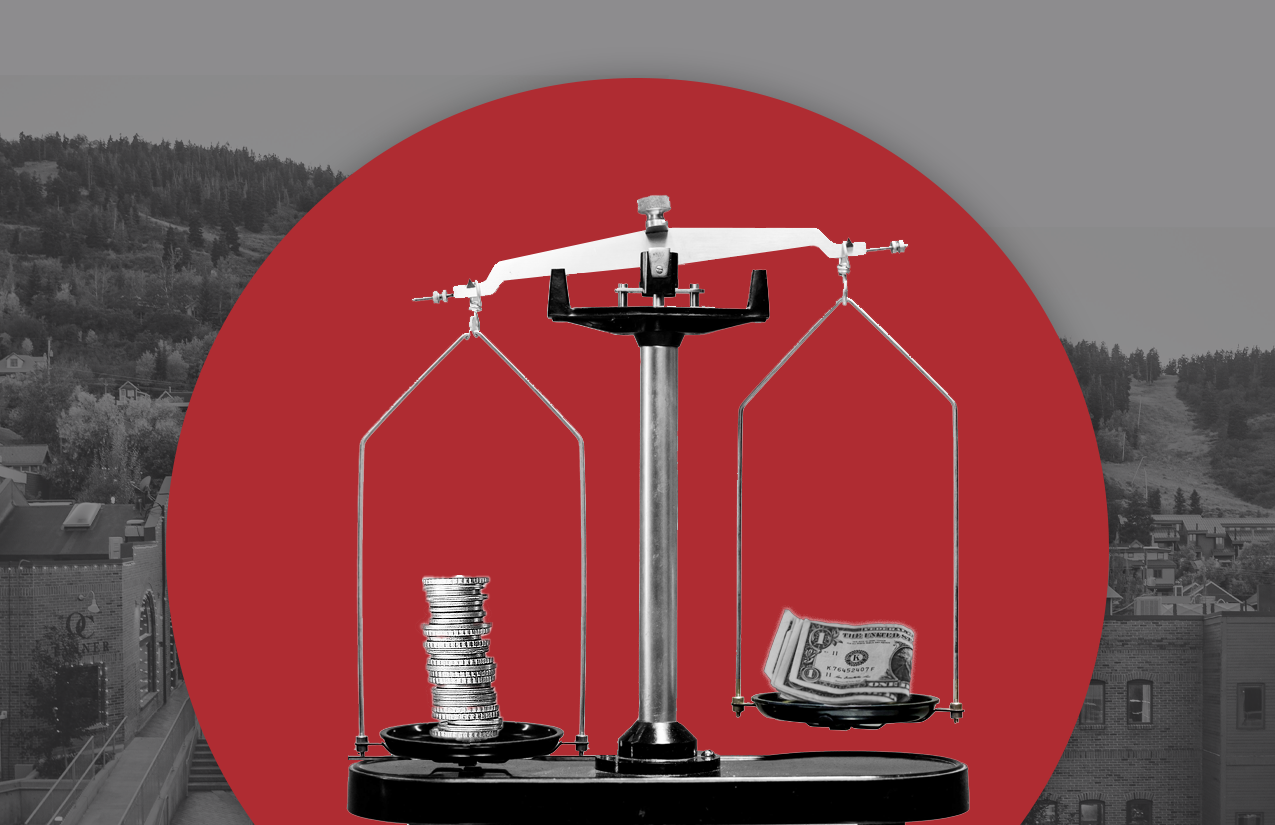Rather than focusing economic development policy on tax incentive “megadeals” which cost hundreds of thousands of dollars per job created, states should expand customized business and job access services to residents of distressed places.

Illustration by Kathleen Bolter; photographs by Cottonbro Studio via Pexels; and Olivia Hutcherson via Unsplash.
Current business-incentive policy trends are unsustainable and should be reformed. Over the past 30 years, states have expanded business incentives—policies that seek to encourage local job creation by providing individual businesses with either cash assistance, such as business tax breaks, or customized business services. In recent years, incentive policies have increasingly emphasized “industrial policies”: in select industries, expensive cash incentives, sometimes exceeding $1 billion per deal, have been awarded to large firms. But future budget realities suggest incentives may need to be cut back. However, job creation continues to be valuable. Thus, states will need to reform incentives to achieve more benefits with less money. Higher benefit-cost ratios for incentives can be achieved by greater targeting of distressed areas and unemployed persons who need jobs the most, and by greater emphasis on “noncash” incentives that have lower costs per job created.
The Rise of the Megadeal
Past research has shown that business incentives tripled in size as a proportion of business output from 1990 to 2015. However, from 2002 to 2015, state incentive trends were more mixed, with some states expanding incentives and other states cutting back. Recently, state and local business incentives have again risen relative to the economy. From 2015 to 2023, incentives grew as a share of the economy by about 8 percent. Because the U.S. economy has also grown, total business incentives during this same period increased by about 30 percent after adjusting for inflation—from $58 billion in 2014–2015 to $77 billion in 2023–2024. More and more, incentives are being used to offer big rewards per job for large projects in specific industries. These state and local “industrial policies” are influenced by the Biden administration’s push to support clean energy and the semiconductor industry.
Megadeals have clearly increased—to an estimated $19 billion in 2022. At least eight of these deals had a total incentive offer exceeding $1 billion. The amount that this works out to per job in some of these deals is unprecedented. In 2015, the median incentive deal was equivalent to about $50,000 per job in today’s dollars. In 2017, the Foxconn incentive offer was considered extraordinarily high per job, at an estimated $277,000 per job in today’s dollars. But in 2022, New York State struck a deal with Micron for a “megafab” plant, at $5.8 billion for 9,000 Micro jobs, or $644,000 per job. In Michigan, a 2019 megadeal for a Ford battery plant in Marshall provided over $1.7 billion in incentives for 2,500 Ford jobs, or almost $700,000 per job.
Among the industries targeted by these megadeals are the federally subsidized industries of semiconductors and clean energy (including electric vehicles). Since the CHIPS Act (Creating Helpful Incentives to Produce Semiconductors for America Fund), semiconductor manufacturers have announced planned domestic investments of over $166 billion. In electric vehicles, there have been at least 23 announced projects in the past three years, amounting to over $66 billion in investment and over $12 billion in planned state incentives.
States have also targeted the film and entertainment industries. For example, in Georgia, film credits will have an estimated cost of $944 million in fiscal year 2024, up over sixfold in real terms since 2015. Georgia’s subsidy can be as large as 30 percent of production costs. In 2023, New York State increased the annual budget cap on its film tax credit from $430 million annually to $700 million. A New York State incentive program for musical and theatrical programs, started in 2021, was recently expanded to $300 million per year.
One trend in some of these megadeals is to offer various types of infrastructure support or training support services, not just cash. This trend is consistent with research suggesting that providing infrastructure and other services is more cost effective in creating jobs than simply providing cash. However, the majority of these deals still largely consist of tax breaks and other cash incentives. For example, the New York State Micron deal was 95 percent cash, 5 percent infrastructure and other community supports. The Michigan Ford deal was 57 percent cash, 43 percent infrastructure and site improvements.
Do These Megadeals Make Sense?
In analyzing the megadeal for the Ford plant in Marshall (Michigan), I found that this megadeal had a benefit-cost ratio of 1.8, but that was only due to three features of this project that increased its benefits. These three features are:
- A very high multiplier, which increases job creation effects
- A location in a moderately distressed county, which increases the impact of the job creation on the local employment rate and earnings per capita
- A funding structure that reduces the likelihood of significant adverse effects on K–12 education spending, and thereby future earnings.
Therefore, for megadeals to make sense, they must be targeted at high-multiplier industries and distressed places, and their funding must not sacrifice important public services. For example, megadeals could be paid for by business tax revenues.
Expanding or even maintaining this current megadeal industrial policy will become increasingly difficult. Most states for the next few years are likely to have limited revenue growth. This tight budget situation makes it more difficult to afford current incentives policies without potentially harming valuable public services. States may need to make cutbacks. As they do so, states should reform incentives to increase their benefits relative to costs. In a climate of state austerity, three incentive reforms should be considered.
Reforming Incentives
First, states should reform incentives to emphasize customized business services over merely handing out cash. Relative to cash incentives, customized business services can cost less than half as much per job created.
Second, states should target a much greater share of incentives on distressed local labor markets. Currently, the percentage of state economic development funding that is targeted at distressed places is typically less than 15 percent. But job creation provides greater benefits in a distressed local labor market. Because distressed places have higher unemployment, job creation boosts employment per capita three times as much in a distressed place compared to an average place.
Third, states should complement job creation policies with efforts to target the created jobs on the unemployed and underemployed. In a typical local labor market, only one-fifth of created jobs go to increase employment of the nonemployed; the remaining four-fifths increase in-migration.
One way to implement these three reforms: states could reallocate some of their incentive budgets to support block grants to local labor markets and neighborhoods that would target distressed areas or neighborhoods, as proposed in my 2022 report. Such block grants would provide customized business services in distressed local labor markets to create jobs through improving infrastructure, business real estate availability, customized job training, and business advice programs. For the unemployed and underemployed in distressed neighborhoods, such block grants would help improve job access—broadly defined to include not only reliable used cars and job training, but also support services such as child care and job retention coaches.
In my 2022 report, I estimated that a block grant program for job creation and job access services in distressed places of about $30 billion per year, maintained over 10 years, would significantly reduce disparities in access to good jobs. This $30 billion per year is less than half of the $77 billion in resources we currently devote to (mostly) cash economic development incentives that are (mostly) untargeted. Such a reallocation would substantially amplify the overall impact of economic development policies on earnings per capita, specifically benefiting low- and middle-income groups that critically require enhanced access to good-quality jobs. This strategic reorientation of resources could significantly alleviate disparities and foster more inclusive economic growth across the nation.
Policy Recommendations
• Expand customized business services in distressed local labor markets to create jobs by improving infrastructure, ensuring the availability of business real estate, customizing job training, and providing business advice programs.
• Expand job access services to the residents of distressed neighborhoods by providing support for reliable transportation, job training, child care, and job retention coaches.
• Complement job creation policies with efforts to target jobs for the unemployed and underemployed.
Author




